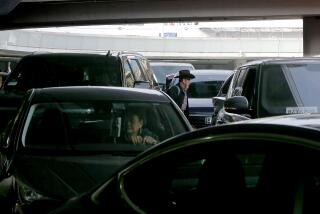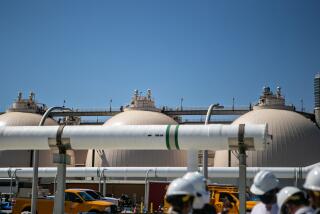Water is contaminated at LAX’s Tom Bradley Terminal
Something bad has been in the water at Los Angeles International Airport for the last several weeks.
With the city in the midst of a sweeping $2-billion transformation of the Tom Bradley International Terminal, airlines that use the facility’s old and new gates have been unable to replenish their aircraft with drinking water because of contamination in the building’s plumbing.
According to airport emails obtained by The Times, the water is brown and contains high levels of bacteria and particles of copper, brass and rust. Officials have conducted a review to see if contamination has also surfaced in the water fountains, dining concessions and restrooms used by passengers in the rebuilt terminal.
The situation has forced international carriers to secure bottled water or forage for fresh water at other terminals, transport it to their planes in tanker trucks and then pump it into the aircraft — a time-consuming process with the potential for flight delays.
In one case, a Cathay Pacific departure was postponed 41 minutes while the ground crew loaded the plane with bottled water.
Officials for Los Angeles World Airports, the operator of LAX, confirmed Friday that for two weeks they and the city’s Department of Water and Power have been dealing with water quality problems caused by discoloration and low levels of chlorine disinfectant at the terminal.
They said the problems are confined to four new gates and one old one and have not appeared in terminal areas used by passengers. After the problem was discovered, fresh water to the terminal’s 13 gates was shut off as a precaution. Officials said the water is safe to drink and supplies have been restored to all but five gates.
“It is not unusual for plumbing in buildings to sometimes cause water to become discolored, resulting in conditions that reduce the amount of chlorine disinfectant present in the water,” officials said in a prepared statement.
They added that the airport agency is assessing the international terminal’s water system to make sure any issues with quality are “isolated and addressed.”
The emails show that the agency’s staff has been trying to solve the problem at least since Nov. 19.
Workers have repeatedly tested the water quality and disinfected delivery systems for potable water at the terminal’s gates, which are equipped with piping, pumps and hoses for the job. Fresh water is used on aircraft for lavatories, meal preparation and to make coffee for passengers.
Eight of the terminal’s new gates, which serve as many as 26 international carriers, were dedicated with much fanfare in March and September. They are part of an ongoing $4-billion project to rebuild the airport’s central utility plant, improve taxiways and expand the international terminal to make room for 18 passenger gates.
According to emails sent between airport operations and environmental officials, at least six of the 13 gates have had water quality issues. They said that months ago, mud, dirt and debris were discovered in the water at Gate 134, on the terminal’s northwest side.
While airport testing has indicated the water is safe, officials stated in a Nov. 23 message that the situation “represents entirely too much contamination from the water supply.” The emails also said that international airlines also have tested the water and found it to be unusable under their tighter standards.
In the last few weeks, the communications reveal that airport officials have also been concerned about a shortage of water trucks to handle the volume of aircraft at the international terminal, many of which arrive at night.
The messages state that officials were worried about potential delays and advised airlines about terminals where fresh water could be obtained, including the remote gates on the western side of LAX.
This isn’t the first time LAX has had to deal with water problems. In March, airport officials handed out bottled water to passengers and employees in Terminal 6 after a cross-contamination incident compromised the building’s fresh water supply.
The contamination occurred when a potable water line became filled with recycled air-conditioning water from another pipe. All food and beverage concessions were temporarily closed under public safety regulations and passengers were directed to get food and drinks in other terminals.
In September 2012, a high-pressure main that supplies water to hydrants at the Bradley terminal burst under a nearby taxiway that had just been reconstructed. A 100-foot-by-160-foot section of pavement that was undermined had to be replaced. The break was blamed on a faulty joint.
More to Read
Start your day right
Sign up for Essential California for news, features and recommendations from the L.A. Times and beyond in your inbox six days a week.
You may occasionally receive promotional content from the Los Angeles Times.







